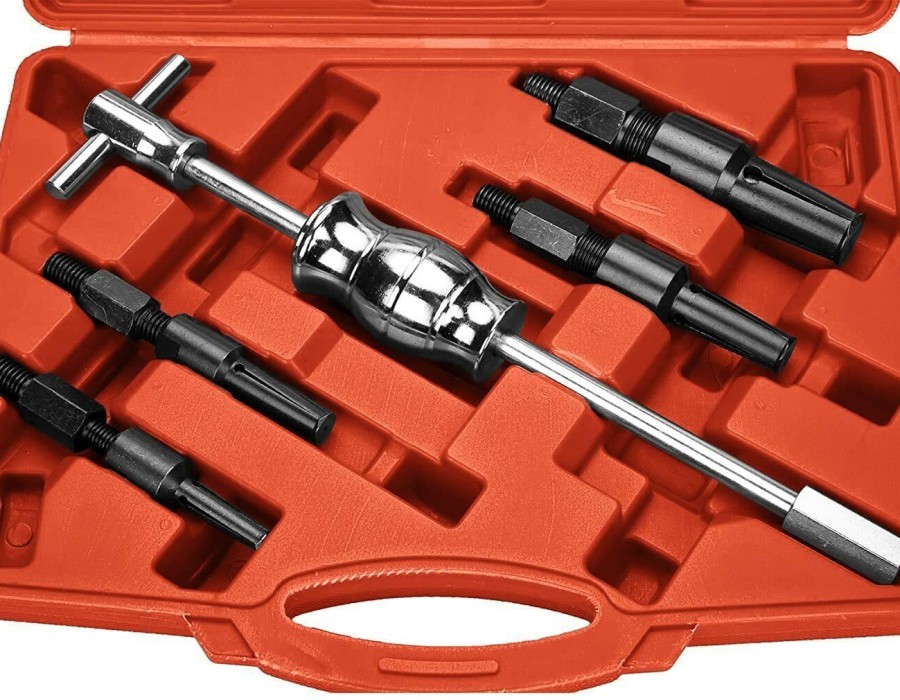When it comes to mechanical maintenance or repair work, removing bearings can be one of the most challenging tasks, especially in heavy-duty applications. Without the right tools, this job can be not only time-consuming but also prone to errors. Whether you're dealing with automotive, industrial, or commercial machinery, a manual bearing puller or a heavy-duty bearing puller is essential for safely and efficiently extracting bearings without causing damage. In this article, we’ll explore the importance of bearing pullers, the differences between manual and heavy-duty options, and tips on choosing the best tool for your needs.
The Role of Bearing Pullers
Bearings are small but critical components in any machinery. They reduce friction between moving parts and allow for smooth, efficient motion. However, over time, bearings can wear out, seize, or simply need replacement during maintenance. A bearing puller is a tool specifically designed to remove these bearings without damaging the shaft or housing.
The right puller not only makes the removal process easier but also ensures the longevity of your equipment. That’s why selecting the appropriate tool for the job is crucial, whether you’re using a manual bearing puller for smaller tasks or a heavy-duty bearing puller for more complex machinery.
What is a Manual Bearing Puller?
A manual bearing puller is designed for small to medium-sized bearings that require careful extraction. These pullers typically have two or three arms (also known as legs) that grip the bearing while a central screw applies force to gently remove the bearing from its position.
Manual bearing pullers are popular because of their simplicity, portability, and effectiveness. They can be used in a wide range of applications, from automotive repairs to industrial machinery maintenance. However, they are best suited for bearings that aren’t too large or tightly fastened.
Features of a Manual Bearing Puller
- Adjustable arms: Most manual pullers have arms that can be adjusted to fit different bearing sizes.
- Screw-driven force: The central screw allows the user to apply controlled pressure, which reduces the risk of damage.
- Compact and lightweight: These tools are easy to transport and require minimal setup.
- Affordable: Compared to hydraulic pullers, manual options are typically more budget-friendly.
The Need for Heavy-Duty Bearing Pullers
For larger or more stubborn bearings, a heavy-duty bearing puller is the tool of choice. These pullers are specifically designed to handle bearings that are tightly lodged in place or used in high-stress environments, such as in industrial equipment, trucks, or other commercial machinery. Heavy-duty bearing pullers often have more robust construction and can apply greater force than manual pullers. Some models may even be hydraulic to handle the toughest jobs.
Key Advantages of Heavy-Duty Bearing Pullers
- Increased force capacity: Heavy-duty pullers are built to handle bearings that require a significant amount of force to remove.
- Durability: Constructed from high-quality materials like hardened steel, these pullers are designed for long-term use in demanding environments.
- Versatility: Many heavy-duty pullers come with multiple arm configurations and attachments to accommodate different bearing sizes and types.
- Precision: Despite their size, these pullers allow for precise extraction, reducing the likelihood of damage to the machinery.
Choosing the Right Bearing Puller for the Job
When selecting between a manual bearing puller and a heavy-duty bearing puller, it’s essential to consider the specific needs of your job. Here are some factors to keep in mind:
- Bearing Size: The size of the bearing you need to remove will largely dictate the type of puller you require. Small to medium-sized bearings can typically be handled with a manual puller, while larger bearings may require the strength of a heavy-duty puller.
- Application: If you’re working in a garage or small shop setting, a manual bearing puller is often sufficient. However, for industrial applications or heavy machinery maintenance, investing in a heavy-duty puller is essential for both safety and efficiency.
- Frequency of Use: For occasional bearing removal, a manual bearing puller might be the more cost-effective choice. However, if you frequently work with bearings, especially in demanding environments, a heavy-duty bearing puller will offer more durability and versatility.
- Accessibility: Some jobs require more delicate maneuvering, such as in tight spaces. Manual bearing pullers are often more compact and easier to manipulate, while heavy-duty pullers may need more clearance for proper use.
- Cost Considerations: While manual bearing pullers are generally more affordable, investing in a heavy-duty bearing puller can be cost-effective in the long run, especially if you regularly deal with larger or more stubborn bearings.
Why Choose Smart Collet Bearing Pullers?
Whether you need a manual bearing puller or a heavy-duty bearing puller, Smart Collet offers a range of high-quality tools designed to make bearing removal efficient, precise, and safe. Smart Collet’s bearing pullers are known for their durability and ease of use, making them a top choice for professionals in a variety of industries.
- Innovative Design: Smart Collet’s bearing pullers feature user-friendly designs that minimize setup time and maximize efficiency.
- Versatility: Their pullers come with adjustable arms and multiple attachments, making them suitable for a wide range of bearing sizes and types.
- High-Quality Materials: Built from high-grade steel, Smart Collet pullers are designed to withstand even the toughest jobs.
By choosing Smart Collet, you’re investing in a tool that not only gets the job done but does so with precision and reliability. Whether you’re handling routine maintenance or dealing with a particularly stubborn bearing, Smart Collet’s bearing pullers provide the performance and peace of mind you need.
Conclusion:
When it comes to bearing removal, choosing the right tool can make all the difference. For smaller, more manageable jobs, a manual bearing puller offers the simplicity and control you need. However, for larger or more challenging tasks, a heavy-duty bearing puller is essential for safely and effectively removing bearings without damage.





Comments